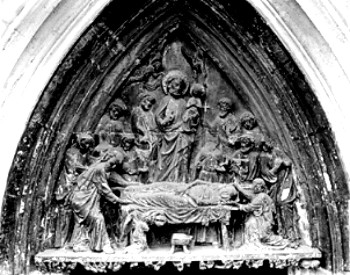Academic thesis
| Tina Bielefeld: | Investigation on selected synthetic resins for a consolidation of differently preserved paint layers and calcite stone. | back |
| Language: | Original - Translation | |
| Overview: |
|
|
 photo: N. Koch, 1990
|
|
| Abstract: | Out of a need of conservation of a relief at the church St. Martini in Braunschweig, an investigation of selected acrylic and polyvinylacetate resins was made on their use for conserving the object. The object dates from ca. 1310/20 and is made of regional Elmkalkstein (limestone). It shows several polychrome and monochrome paint layers, which are mostly of oil-proteineous media. Stone and paint layers are all differently well preserved. The main reason for the damages are a build-up gypsum and dirt layer within the objects overall surface and an oil conservation treatment from 1842. First, a summary of scientific analyses which have been carried out during the past 20 years is given. Analyses concerning salt presence and the surfaces´ resistence to liquids are added. Sequently, acrylic and polyvinylacetate resins are chosen from the group of synthetic resins. The selected resins have been frequently used in conservation. They were tested comparatively on their properties of water vapor permeability, air permeability, behaviour in high humidity, compeability with salts, adhesive properties and resistence to cyclic change of temperature. All polymers were each tested in two different concentrations, both as resins in organic solvent (butylacetate) and as emulsions. The tested resins all proofed to be highly or mainly permeable to water vapor, so that the final decision to use the acryl resins (Paraloid® B 72 und Primal® AC 33) on the object based on the results of the other tests. The resin in organic solvent was proposed as consolidant for the stone, whereas the emulsion proofed to be rather suitable as consolidant for the paint layers. Some questions had to remain unanswered, such as the long term stability of the resins considering that there is a low, but important presence of salts at the object. It was found out that salts remain hygroscope when added to a polymer structure. For conserving exposed objects, synthetic resins are not often used because they remain water resistant after drying. The relief has been mostly protected from weathering because a plexiglas cover was put up in 1998. Its situation is therefore not completely comparable to any other outside object. It was proposed to carry out a regular maintenance once the acrylics have been applied on the object - not only in order to preserve the object but also to monitor the stability of the synthetic resins. |
| Keywords: | acrylic resins, polyvinylacetate resins, limestone, paint layers, oil-proteineous media, gypsum, dirt, Paraloid, Primal |
| Details: |
|
| Contact: |
Tina Bielefeld Bürgerstraße 28 Tina Dömling (geb. Bielefeld) 01127 Dresden Deutschland |
| Download: |
full-text thesis (pdf-data format, approx. 2.55 MB) |
| DOI (Digital Object Identifier) | 10.5165/hawk-hhg/94 |
The Hornemann Institute offers only the information displayed here. For further information or copies of academic work, please contact the author or - if there is no contact provided - the secretariats of the respective faculties.